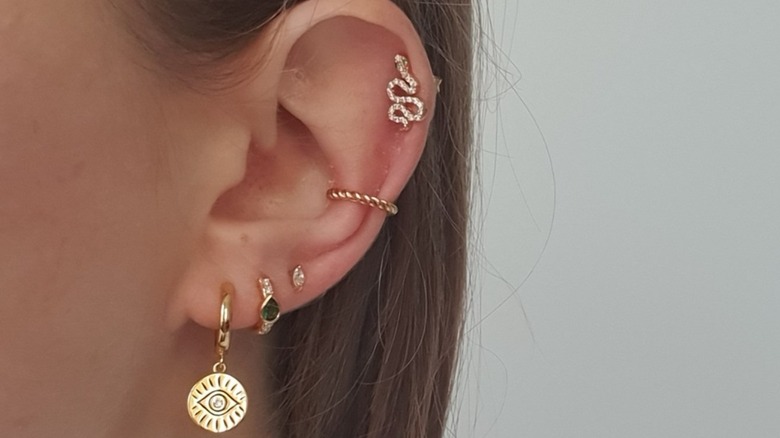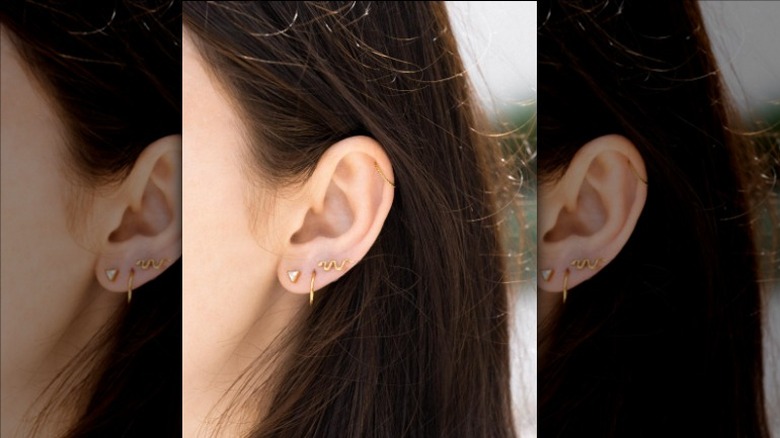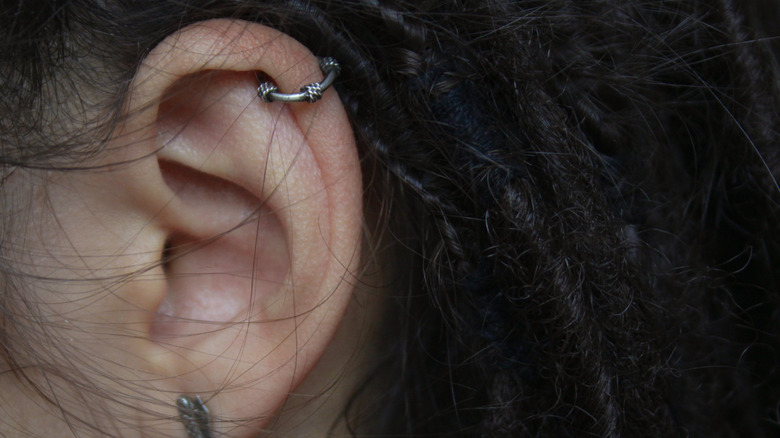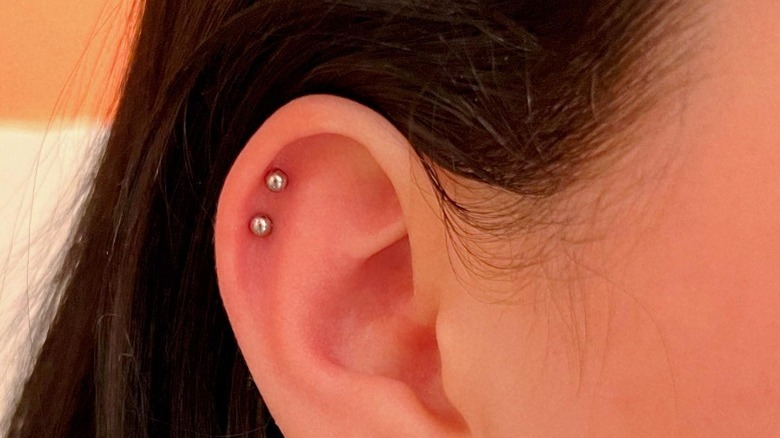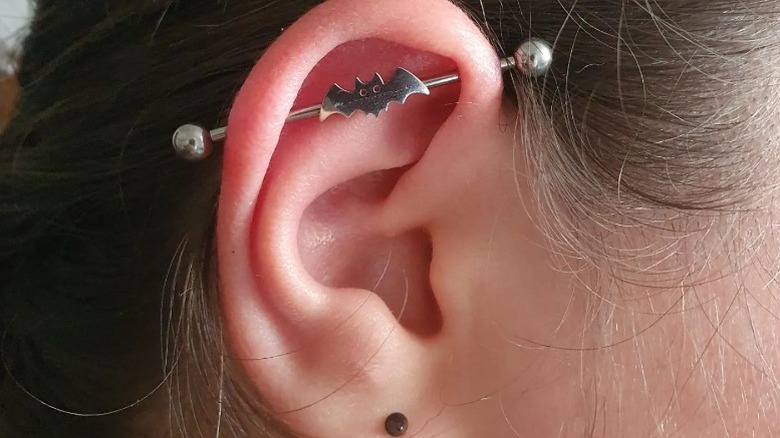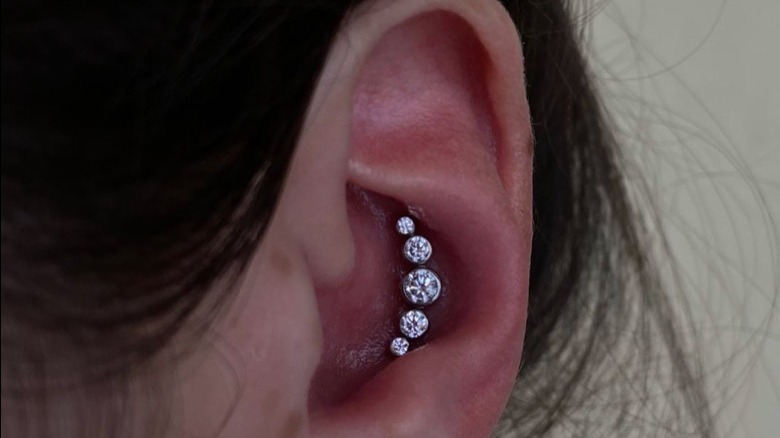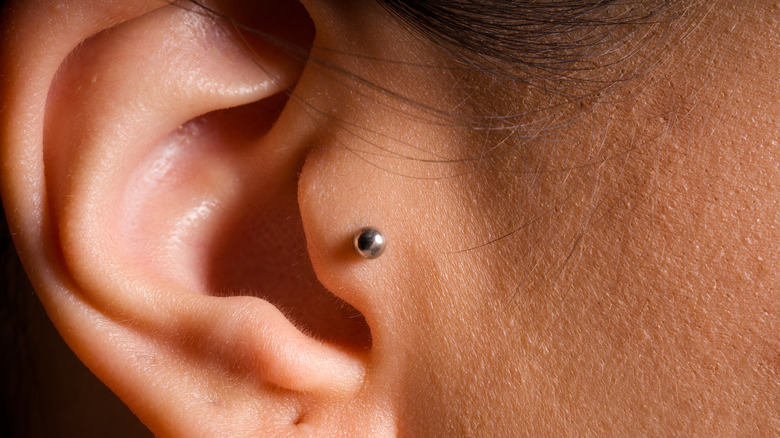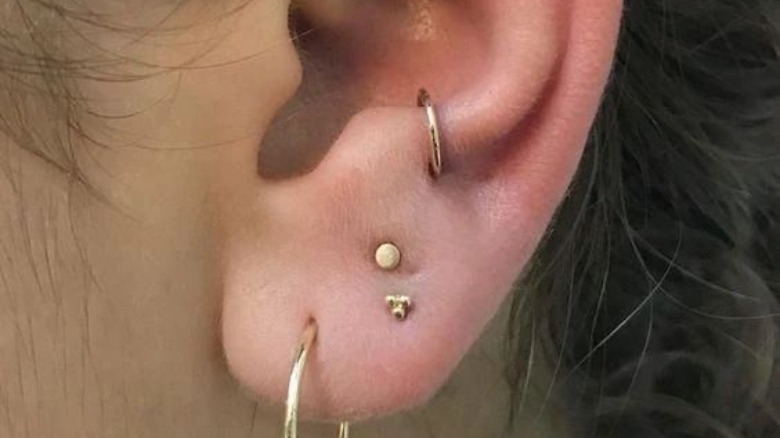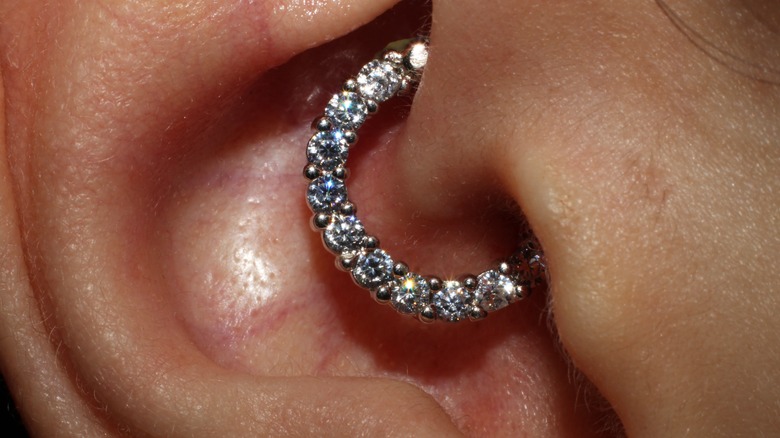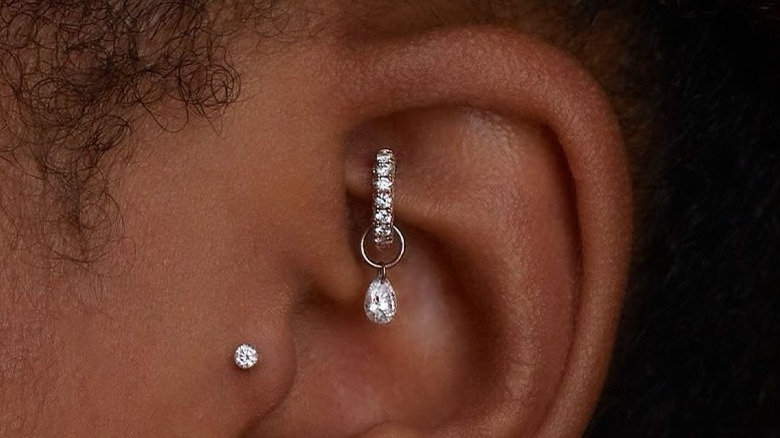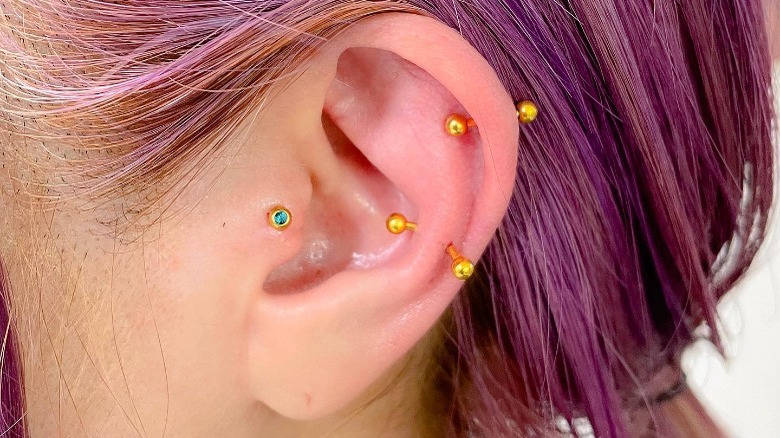Your Ear Piercing Cheatsheet For The Perfectly Curated Earring Stack
Did you know that ear piercing started more than 5,000 years ago? It was believed that different ear piercings could represent a person's various travels, wealth, and status in many cultures. While piercings may have been symbolic back in the day, though, just about anyone can rock ear piercings today. In fact, piercings can not only be therapeutic but also, when styled and stacked together, make the perfect everyday accessory to just about any outfit.
Despite the initial pain of getting a piercing, most ear piercings heal rather quickly with proper aftercare. This makes it very tempting to start your own curated earring stack — and we're here to help. Here's everything you need to know about the trendiest ear piercings, from how painful they are, to how long they take to heal, and even the best ways to style them. Follow along to get started on your own customized earring stack.
Stacked Earlobe
A stacked earlobe piercing typically consists of your standard piercing with a second or third piercing often added on. These piercings sit at different heights on the lobe and are pretty timeless as they can be easily styled with mini gemstones, small matching hoops, or even studs. Plus, since these piercings sit in a fleshy part of your ear, they are pretty painless. People usually report they are not more than a three or four out of 10 on the pain scale.
A lobe piercing can cost between $25 and $50, depending on the exact location of your piercing as well as the jewelry you choose to pierce your ear with. Typically, these piercings will also heal rather quickly, taking between six and eight weeks. A good rule of thumb for a polished ear stack is to start with the biggest piece of jewelry on the bottom and then work backward in terms of size, as you go higher up on your earlobe. This works especially well with triple hoops of varying sizes. Alternatively, you can also wear various geometric shapes and sizes for a more whimsical and carefree look.
Helix
You may have heard a helix piercing referred to as a cartilage piercing. This trendy ear piercing is usually located in the outer cartilage of the upper ear. Typically, a single standard helix piercing costs between $30 and $75, and can be styled with a hoop, barbell, beaded ring, or even a simple stud. The piercing is typically reported to be slightly more painful than a lobe piercing, with people usually rating it at a five or six out of 10 on pain.
If you're considering a helix piercing, it may be important to first consider what side you sleep on. Putting extra pressure on your helix piercing while you sleep can not only delay the healing process, but also increases the chance of ripping or snagging your fresh piercing at night. So side sleepers should definitely proceed with caution. With proper maintenance, your helix piercing should heal in about two to four months.
Double Helix
If you're looking to take your traditional cartilage piercing to the next level, then a double helix or cartilage piercing might be a good fit for you. This piercing consists of two holes in the cartilage area of the ear that are placed right next to each other. In fact, the placement of the double helix piercing is great as it works with both small hoops and studs, or even a mixture of the two.
Depending on the build of your ear, the cartilage can be a sensitive area to get pierced for some individuals. So, if you're considering getting a double helix piercing, it might be helpful to first consult a piercer to see if it's the right fit for you. Typically, the piercing is said to be at a medium pain level, which means it can hurt more than a standard lobe piercing. "I think people in my chair usually give it a four-to-seven in terms of pain," says piercer Hannah Ruhga in an interview with Byrdie.
It's also important to remember that the double helix is two separate cartilage piercings, which means they'll have to pierce your ears twice. Though it is recommended to get them during a single visit to the piercer so that you can coordinate their alignment and allow them to heal together. It can take up to six months for the piercing to fully heal with proper care and should generally cost between $30 and $75, depending on your piercer.
Industrial
If you want something truly edgy and bold, then an industrial piercing may be a good choice for you (although we also love ear cuffs for an edgy look without the commitment of a full piercing). This piercing actually consists of two ear piercings in the ear's cartilage, one in the forward helix, near where the ear meets the skull, and the other across from it where a normal helix piercing sits. These two piercings are connected by a barbell and sit inside the ear.
"Most people do not have the right anatomy to get a traditional industrial piercing," says piercer Eden Cox in an interview with Byrdie. "That's why it's important to research your piercer and find one that will work with your anatomy and do something suitable for the shape of your ear." If you do get the green light for an industrial piercing, expect the pain level to be on the higher side, between six and seven, especially because you're getting two different piercings. The average cost of this piercing is between $40 and $70, depending on your piercer.
Similar to many cartilage piercings, you can expect your industrial piercing to take around six months to heal. After this initial healing period, you can play around with different types of jewelry for your industrial piercing, including silver and gold barbells with various bold designs to get the traditional look of an industrial piercing.
Conch
The conch is the perfect in-between piercing, located literally in the center of your ear. The piercing gets its name from the area of the cartilage it's placed in, that looks like a conch shell, located in the middle part of your ear. This piercing is one that looks good on multiple ear types. "In my many years of piercing, I have not come across one that wasn't suitable," says piercer Rhianna Jones in an interview with Byrdie.
You can also choose between an inner or outer conch piercing. The inner conch sits on the lower cartilage, while the upper conch usually sits on the upper cartilage in the outer rim of the ear. With an upper conch, you have more versatility in jewelry options and can choose between both large studs and hoops that line the ear. Meanwhile, your options are a bit more limited for the inner conch piercing because of its position. However, you can still have fun with smaller studs.
This piercing can cost anywhere between $30 and $90, depending on your piercer. Similar to the helix piercing, you might want to find out if your piercing interferes with how you sleep, as it can get infected easily. Typically, this piercing takes between six to nine months to fully heal. Since the cartilage that is involved in this piercing is located in a thicker and more intricate part of the ear, it can rank around a seven out of 10 for pain.
Tragus
There's a lot that can go wrong when getting your tragus pierced. The position of this piercing sits in the thick piece of flesh that is right in front of the ear canal, making it more susceptible to infections, ear wax, and dead skin cells. Yet, this can also make for a very unique and eye-catching piercing, making it rather popular. Plus, the pain level for this piercing is actually less than what you might expect, with most rating it between a four or five out of 10. This is because there are fewer nerves located in the tragus area than in other parts of your ears, making it less sensitive and painful (per Grazia).
A tragus piercing can cost between $25 and $50. Typically, the tragus is pierced with a stud, which you should keep in while it heals for about six to eight weeks, after which you can change to a more colorful earring stud. However, a tragus piercing can sometimes take up to a year to fully heal.
Anti-Tragus
Funky piercings are making a comeback, and if you're on the hunt for something unique, look no further than the anti-tragus piercing. This piercing is on the small piece of cartilage opposite the ear canal. The price of this rare piercing is around $30 to $100, depending on whether you go for a piece of jewelry that is bold or understated.
While the piercing might need only six to eight months to fully heal, it's known to hurt a lot more than a standard lobe piercing and even a traditional tragus piercing, making it at least a six or seven out of 10 on the pain scale. Despite the increased pain you have to endure for this piercing, the anti-tragus piercing can also be really fun because of all the different pieces of jewelry that you can mix and match, like cartilage hoops, flat back earrings, circular barbells, ball closure rings, and curved barbells. Just be sure that your piercing is large enough to support thicker pieces of jewelry and is fully healed before you change it.
Daith
Did you know that a daith piercing is commonly said to treat migraines? Although there is no medical research to support this theory, a daith piercing, located in the innermost fold of the ear, does lie very close to an acupuncture point that is targeted to relieve migraines and frequent headaches (per Cleveland Clinic). Still, if you're considering getting a daith piercing to treat migraines, it's important to be aware that what might really be at play is a placebo effect, where any relief is purely mental rather than physical. On the plus side, the daith piercing does look effortlessly chic, despite controversy over its benefits.
The daith piercing is located where the inner ear meets the outer ear, making it around a six out of 10 for most people on the pain scale. Because of the piercing's peculiar position, a special type of curved needle is used to pierce the area. That's why it's important to ensure that your piercer is familiar with daith piercings before getting one. The piercing will also need to heal for around nine months, after which it can be styled with various pretty cartilage hoops with intricate designs. A daith piercing will typically cost you anywhere between $30 and $80, depending on the person who does the piercing.
Rook
The rook piercing is a perfect example of how inventive ear piercings have become over time. This piercing sits precariously on a dense fold of cartilage located just between the inner ear and the outer ear. What is especially unique about this piercing is that it is pierced vertically instead of horizontally and is typically styled with curved barbells, beaded jewelry, or even hanging hoops with gems that can dangle just beneath the rook.
Since the rook piercing has to be pierced through a double layer of cartilage, it can be quite painful for a lot of people and typically ranks between eight and nine on the pain scale. It typically costs anywhere between $30 and $60 and can take around six to nine months to fully heal. It's also important to avoid wearing headphones while the piercing heals, since this specific piercing's position means they can interfere with or prolong the healing process.
Snug
If there's any piercing on this list that might be considered the most painful, it's the snug. The pain of this piercing has everything to do with the thick cartilage piercers need to get through to do this piercing. Helix piercings may have become commonplace, but "The snug, however, connects from point-to-point from the middle of your helix to the inside of your conch (the bowl) of your ear," explains Matt Mayfield, piercer at New York Adorned in an interview with PopSugar.
While the exact pain level depends on each person, most people rank this piercing a nine out of 10 on the pain scale. This piercing also requires a longer time to fully heal, with some snug piercings taking up to 12 months. This piercing will also cost you around $35 to $70, depending on the piercer and type of jewelry that you choose.
Despite the pain and longer healing time, this piercing can be really fun to style with various curved barbells, the most common being titanium, gold, and stainless steel barbells. Needless to say, this is one of the most unique piercings that you can get on your ear.
